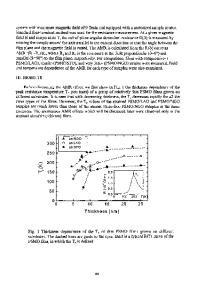Micromagnetic and Magnetoresistance Studies of Ferromagnetic La 0.83 Sr 0.13 MnO 2.98 Crystals
- PDF / 1,701,310 Bytes
- 6 Pages / 612 x 792 pts (letter) Page_size
- 47 Downloads / 289 Views
Micromagnetic and Magnetoresistance Studies of Ferromagnetic La0.83Sr0.13MnO2.98 Crystals Guerman Popov,a Sergei V. Kalinin,b Rodolfo A. Alvarez,b Martha Greenblatt,a and Dawn A. Bonnell b a Department of Chemistry, Rutgers, the State University of New Jersey, Piscataway, New Jersey 08854, USA b Department of Materials Science and Engineering, University of Pennsylvania, Philadelphia, Pennsylvania, 19104, USA
ABSTRACT Magnetic force microscopy (MFM) and atomic force microscopy (AFM) were used to investigate the surface topography and micromagnetic structure of La0.83Sr0.13MnO2.98 single crystals with colossal magnetoresistance (CMR). The crystals were grown by fused salt electrolysis and characterized by chemical analysis, X-ray diffraction, magnetic and transport measurements. The crystals are rhombohedral (R 3 c). Magnetic and transport measurements indicate that the ferromagnetic ordering at 310 K is associated with an insulator-metal transition at the same temperature. A maximum negative magnetoresistance (-62 %) is observed at 290 K in an applied magnetic field of 5 T. The magnetoresistance increases in magnitude sharply (1.8 %), comparing to the rest of the change, with increasing magnetic field up to 20 G, and then it increases slowly with increasing field. MFM and AFM were used to study the (110) surface as well as a number of unspecified surfaces. Surface topography of an as-grown crystal exhibits well-developed surface corrugations due to extensive twinning. The corrugation angle at twin boundaries can be related to the unit cell parameters, surface and twinning planes. Magnetic force microscopy images show that magnetic domain boundaries are pinned to the crystallographic twins; a small number of unpinned boundaries are observed. The statistical analysis of domain boundary angle distribution is consistent with cubic magnetocrystalline anisotropy with easy axis along [100] directions for this material. Unusual magnetization behavior in the vicinity of topological defects on the surface is also reported. MFM contrast was found to disappear above the ferromagnetic Curie temperature; after cooling a new magnetic structure comprised of Bloch walls of opposite chiralities developed.
INTRODUCTION LnMnO3-type rare earth manganates have received recent interest, because of the discovery of colossal magnetoresistance (CMR), the effect by which the electrical resistivity decreases by orders of magnitude upon the application of a magnetic field. CMR properties of polycrystalline materials and thin films have been studied extensively. It was shown that CMR behavior in many cases is associated with magnetic disorder at grain and domain boundaries [1]. Hence, the origins of CMR behavior of these materials can be best understood from the combination of spatially resolved local and single crystal studies. La1-xSrxMnO3 is a typical perovskite CMR system [2-7]. Its structural symmetry changes from orthorhombic to rhombohedral with increasing x up to 0.8. Depending on x in GG5.6.1
La1-xSrxMnO3 and oxygen stoichiometry th










